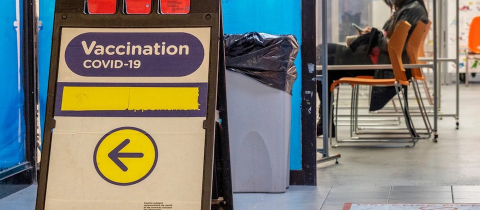"The presence of a chemical does not equate to the presence of risk.” I have often used that argument when talking about potentially toxic substances that are present in the environment. Bisphenol A, phthalates, flame retardants, polyfluorinated compounds and pesticides are among the many substances that can cause harm if exposure is significant, but the cornerstone of toxicology was laid some five centuries ago with Paracelsus’ famous dictum that “only the dose makes the poison.” This applies to viruses as well as to chemicals. For an infection to occur, a sufficient number of viral particles capable of reproduction have to find their way into the body. We know this can happen by breathing in exhaled droplets and aerosols from an infected person, but can one be infected with the SARS-CoV-2 virus by touching a surface that harbours the virus?
Discussions about transmission via “fomites” began as soon as it was clear that a novel virus capable of causing potentially severe illness had emerged from China. “Fomite” is the scientific term for any inanimate object that when contaminated with infectious agents can transfer disease to a new host. The concern is that viral particles exhaled by infected people may settle on surfaces and cause infection if these are touched by someone prior to touching their face. Of course, the possible presence of the virus on surfaces was never in doubt. People cough and sneeze, and the virus-bearing droplets they expel must end up somewhere. Heavier droplets fall down more quickly while small droplets in the form of aerosols can travel further.
The first question that had to be answered was how long a virus can remain viable on a surface, that is, capable of causing an infection. That wasn’t too difficult, just required the placing of a dose of virus on a surface and swabbing the surface periodically to determine if the viral load picked up can be cultured in special host cells that are known to be prone to infection. It turns out that the virus degrades quickly on copper, but can last days on stainless steel, plastic and paper. When these results were first reported, the public went into a frenzy, wiping cereal boxes, milk cartons, jars and take-out containers with various disinfectants, namely chemicals capable of destroying harmful microorganisms. Furthermore, people took to storing groceries, mail and magazines in the garage until sufficient time was deemed to have passed to “kill” the virus.
One problem is that in the laboratory studies, the applied viral loads were in a medium that was supposed to be similar to saliva but wasn’t saliva. That makes a difference since saliva itself has some antimicrobial properties. What we really need to know is whether there are viruses on surfaces that people would actually contact in their daily life, and from which enough viral particles can be picked up to cause infection. Of course, the study that would actually answer this question cannot be done. Ethically, it is inappropriate to carry out a study in which people would be asked to handle fomites contaminated with different amounts of virus and then touch their face to see what happens.
What can be done, is to swab surfaces where the virus may exist and then see if the virus can replicate in host cells. A couple of such studies have been carried out and provide important clues. In an Israeli study, swabs were taken from surfaces in two hospital isolation units, as well as in a hotel where people who had tested positive for the virus were quarantined. Although the virus from the samples could be detected for days in the lab, none of the samples caused infection in host cells. A similar study in an Italian hospital came up with similar results. Positive swabs were unable to infect cells, leading the researchers to conclude that environmental contamination with the virus is unlikely to cause infection in real-life conditions.
Admittedly, “unlikely” is not “impossible.” It is conceivable that if an infected person coughs or sneezes on a surface, or touches it with a hand with which they just wiped their nose, and another individual then touches that surface soon after, and then their face, infection can ensue. Does this possibility call for spraying or fogging spaces where people gather, such as educational institutions, malls or offices with disinfectants? In the absence of controlled trials, it is a judgment call. Not only about whether or not to spray, but if the decision is to disinfect, then spray with what?
In the early days of the pandemic, in many Asian cities trucks equipped with sprayers cruised streets and workers clad in protective gear could be seen spraying storefronts, lampposts, railings and even trees with dilute hydrogen peroxide or hypochlorite bleach. Since the virus is readily degraded outdoors by sunlight, as are disinfectants, it was never clear that this mode of disinfection had any effect, especially given that people do not go around hugging lampposts or kissing sidewalks. Inhaling disinfectants is not innocuous, and there are possible environmental consequences as well. In any case, the World Health Organization has concluded that outdoor spraying is not recommended.
Indoor spraying is a gray area. While it may be of some use in hospital wards populated by COVID patients, it makes no sense to spray if people can be exposed to the spray. Airplanes can be treated when empty, as well as classrooms, offices and houses of worship, but there is no evidence that this helps to cut down on infections since transmission via fomites is believed to be uncommon in the first place. And there is the issue of frequent disinfection actually harming fabrics and furniture as well as workers who may be doing the spraying without adequate protective gear.
If spraying is to be done, hypochlorous acid appears to be a good choice since it is far more effective than sodium or calcium hypochlorite, meaning that a lower concentration can be used. Hydrogen peroxide at a concentration of 1% is often used, but given that peroxide breaks down relatively quickly into water and oxygen, its effectiveness is questionable. Many foggers use quaternary ammonium compounds which are effective disinfectants, but questions have been raised about possible toxicity based on animal studies.
Is there a bottom line here? Unfortunately, nothing about this virus is certain. Wiping heavily-used surfaces with a disinfectant may not do much good, especially if those surfaces are not clean in the first place. Viruses can hide in the nooks and crannies of dirt particles. Quaternary ammonium compounds or “quats” would not be my first choice for disinfecting, and the scent of hypochlorite bleach can be irritating to some people. Alcohol or dilute hydrogen peroxide are at least harmless to us and fortunately not to microbes. However, instead of worrying about disinfecting surfaces, there is potentially a greater payoff in concentrating on not touching the face after handling fomites, and of course, on frequent and proper hand washing.







